*This page may include affiliate links, which means that if you make a purchase through one of the product links, we may receive a small commission. For full affiliate disclosure please see our disclaimer page.
If you’re like me, you know that nail-trimming day can sometimes feel like an Olympic event. Whether it’s the nervous dance we do around our furry friend, the hopeful bribery with their favorite treats, or that deep sigh of relief once it’s all over—many of us have been there. Nail trims are essential for our pups, but for some reason, many of our four-legged companions seem to view the humble nail clipper as their arch-nemesis. But what if I told you that nail trimming doesn’t have to be a dramatic episode? Yep, it’s true! Over the years, I’ve gathered some tried-and-true techniques to transform this daunting task into a stress-free experience, both for you and your dog. In this blog, we’ll explore five safe and effective ways to calm your dog to cut nails, ensuring that the process is as smooth and comfortable as possible. Grab your doggo, a cozy spot, and let’s dive in together! 🐶✂️

1. Understanding Your Dog’s Fear
Before we jump into tactics and strategies, let’s take a moment to understand our pups a bit better. Understanding why our dogs may be afraid can make all the difference in addressing their fears compassionately.
Why Some Dogs Are Afraid of Nail Trims
- Past Traumas: Just like humans, dogs can develop fears based on past experiences. If they’ve had a painful nail trim before (like cutting into the quick), they might associate the clippers with pain.
- The Sensation: Dogs have heightened senses. The pressure of nail cutting, even when painless, is an unfamiliar sensation for them.
- Sound and Vibration: The sound of the clippers or the slight vibration it might cause can be startling or unnerving for some dogs.
- Natural Instinct: It’s worth noting that in the wild, showing vulnerability can be risky. Allowing their paws to be held exposes them to a vulnerable position.
Recognizing the Signs of Stress in Your Dog
Understanding when your dog is stressed is vital to ensure their comfort. Here are some signs:
- Vocalizations: Whining, whimpering, or growling can be indicators of distress.
- Body Language: Tucked tail, pinned ears, and dilated pupils are all signs your dog is feeling uneasy.
- Avoidance Behavior: If they’re hiding, trying to pull their paw away, or constantly looking away from you and the clippers, they’re probably anxious.
- Excessive Grooming: Some dogs might lick their paws or lips excessively when they’re nervous.
It’s essential to remember that every dog is an individual. What terrifies one might not faze another, and vice versa. By truly understanding our canine companion’s fears and signals, we can approach nail trimming with empathy and kindness, ensuring a positive experience for both. After all, as they say, knowledge is power – or in this case, the power to give a gentle, stress-free trim! 🐾💕
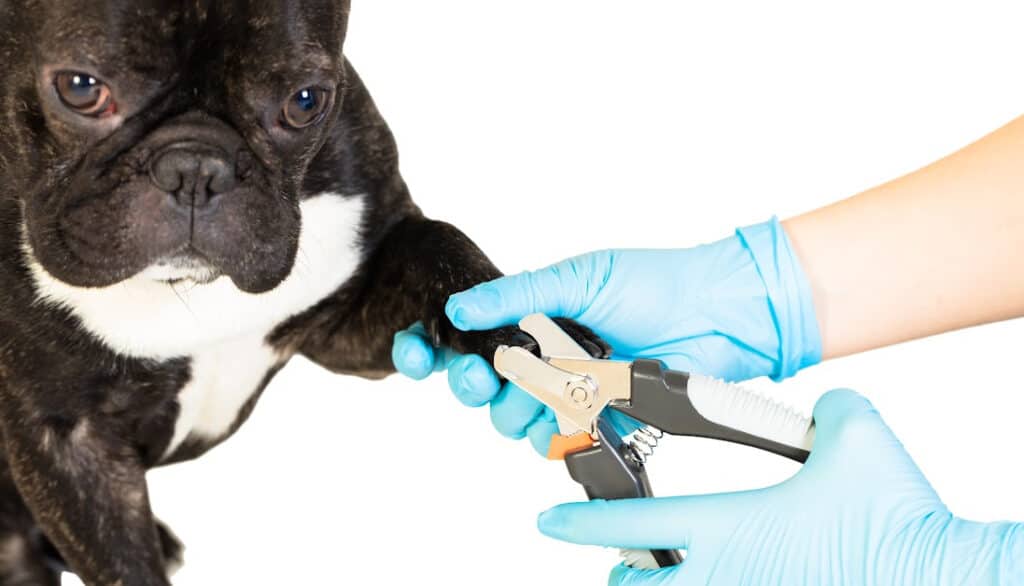
2. Preparing the Environment
Alright, now that we’ve dipped our toes into the world of canine emotions, let’s set the stage! The environment in which you trim your dog’s nails plays a huge role in how the experience unfolds. Think of it as setting the mood for a relaxing spa day instead of a trip to the dentist. 🐕🧖♂️
The Role of a Familiar and Quiet Space
- Comfort Zone: Always choose a spot where your dog feels at ease. This might be their favorite lounging area or where they often play. Familiarity breeds comfort!
- Avoid Distractions: Reduce sudden loud noises or other potential distractions. Perhaps wait until the mail has been delivered so the doorbell doesn’t ring, or do it at a time when the neighborhood kids aren’t playing loudly outside.
The Importance of the Right Tools
- Quality Clippers: Invest in a pair of quality dog nail clippers that are sharp and the right size for your dog. Dull clippers can cause splitting or crushing of the nail, which is uncomfortable.
- Safety First: Consider clippers with safety guards to avoid over-trimming. And always have styptic powder on hand just in case you nick the quick.
- Alternative Tools: For dogs especially nervous about clippers, consider using a nail grinder. They’re quieter and reduce the chances of cutting the quick. Just ensure you introduce the grinder slowly, so the vibration doesn’t startle them.
How Ambient Music or White Noise Can Help
- Soothing Sounds: Just as some of us humans enjoy calming music during a massage, dogs can also benefit. Consider playing some soft instrumental music or nature sounds to create a serene atmosphere.
- Drown Out the Scary Noises: White noise machines or even a fan can help mask any unexpected noises that might occur during the session, ensuring your dog isn’t suddenly jolted by a car honk or other startling sounds.
Setting up the perfect environment is akin to laying the foundation for a house. With the right surroundings and tools, you’re paving the way for a relaxed and efficient nail-trimming experience. After all, our pups deserve nothing but the best! 🏡🐾🎶
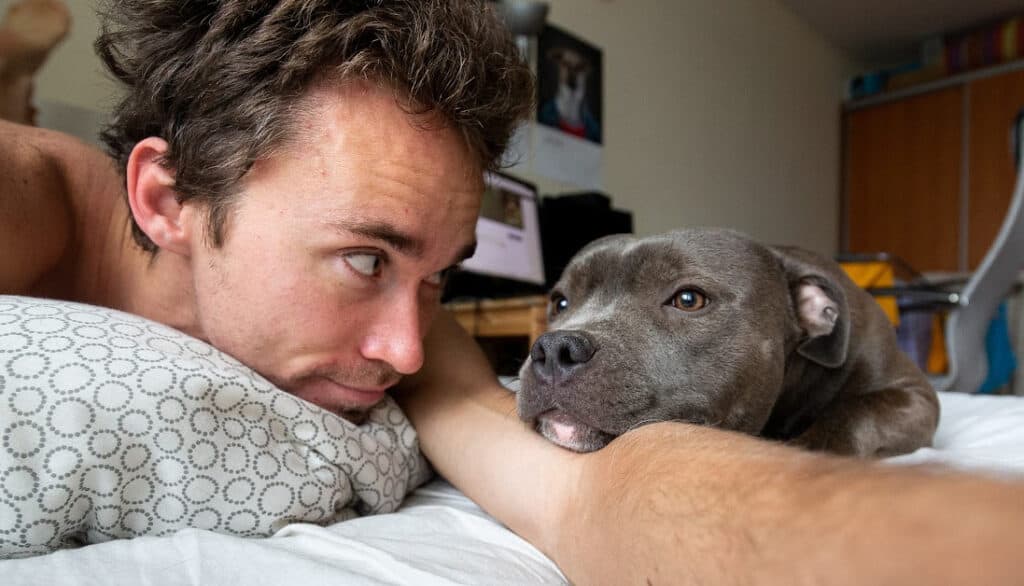
3. Desensitization and Positive Reinforcement
Hey, dog lovers! As we embark on this topic, let’s acknowledge something: change can be hard, especially when it involves confronting our fears. But with patience, consistency, and a sprinkle of positivity, we can help our furry friends adjust. Here’s how to use desensitization and positive reinforcement to make nail trims a walk in the park… or at least less of a hurdle. 🌳🐕
Introduction to Desensitization and Its Importance
- Baby Steps: Desensitization is all about introducing our dogs to nail trimming slowly and in controlled increments. Instead of jumping straight into a full-blown nail trim, we break the process down into baby steps.
- Building Trust: This approach not only helps in reducing fear but also builds trust. When our dogs understand that the clipper or grinder isn’t out to get them, they’re more likely to cooperate.
Step-by-Step Guide to Desensitization
- Clipper Introduction: Before you even think of trimming, let your dog inspect the nail clipper or grinder. Place it near their toys or feeding area for a few days. Curiosity might just get the better of them!
- Mock Trimming Sessions: Hold your dog’s paw gently and mimic the motion of trimming without actually doing it. This helps them get used to the sensation.
- Short Sessions: Once they seem more comfortable, try trimming just one nail and then giving them a break. Slowly increase the number of nails you trim in one sitting over time.
- Consistent Practice: Regular, short sessions are better than rare, long ones. It keeps the routine familiar and less daunting.
The Magic of Positive Reinforcement
- treats Galore: After every positive interaction with the nail trimmer or a successful trim, reward your dog with their favorite treat. It builds a positive association.
- Verbal Praise: Don’t underestimate the power of a cheerful “Good job!” or “Well done!”. Dogs pick up on our enthusiasm and love being praised.
- Playtime: Maybe after a nail trimming session, engage in a short play session. It serves as both a distraction and a reward.
Remember, desensitization and positive reinforcement is a journey, not a destination. There might be setbacks, but with persistence, understanding, and lots of love, nail trimming can become a stress-free, or dare we say, enjoyable activity for you and your pup! 🌈🐾🍖

4. Physical Relaxation Techniques
Hello to all the pet enthusiasts out there! Now that we’ve journeyed through understanding, preparation, and gentle desensitization, let’s dive into some hands-on (or paws-on) techniques. These physical relaxation strategies are like giving your dog a mini spa session. The idea is to combine the comforts of a massage with the necessity of a nail trim. Let’s pamper those paws! 🐕💆♂️
Gentle Massage Techniques for Relaxation
- Paw Massages: Start by gently massaging the pads of their feet. The soft circular motions can help to soothe any tension they might be holding in their paws.
- Full Body Massage: Gradually expand your touch, moving up their legs, along their spine, and to their neck. Paying attention to areas your dog particularly enjoys can be a game-changer.
Pressure Points Known to Help Dogs Calm Down
- Base of the Ear: Gently rubbing the base of your dog’s ears can have a calming effect. It’s a sensitive spot many dogs love being petted or massaged.
- Chest Rub: Many dogs find gentle strokes or circular massages on the chest soothing. It’s a great way to bond and promote relaxation.
The Role of Calming Wraps or Anxiety Vests
- Swaddling Comfort: Just as swaddling can soothe a baby, a calming wrap provides gentle, constant pressure that can help calm a nervous dog. It’s especially handy for pups who have a heightened fear of nail trims.
- How They Work: These vests or wraps apply gentle pressure to the dog’s body, which can produce a calming effect. It’s similar to the concept of weighted blankets for humans.
Integrating these relaxation techniques isn’t just about nail trims. It’s about enhancing the bond between you and your dog, understanding their body language, and providing comfort. Every massage, every gentle rub is a reminder that you’re there for them, through the fun times and the nail trims. So, next time, before you pick up those clippers, take a moment to indulge in some relaxation techniques. It could turn your dog’s nail-trimming session from a chore to a cherished moment. 💕🐾🌸

PRO TIP: Calming Essential Oils
Alright, before we continue, here’s a little golden nugget of advice for those looking to go the extra mile in ensuring a tranquil atmosphere for their dogs. 🌿✨
Harnessing the Power of Essential Oils: Certain essential oils are known for their calming properties. When used correctly and safely, they can provide an added layer of relaxation for your furry friend.
- Lavender: This oil is renowned for its soothing properties, not just for humans but for dogs as well. A whiff of lavender can help reduce anxiety and stress.
- Chamomile: Known for its natural calming effects, chamomile can aid in soothing an upset or nervous dog.
- Frankincense: This ancient essential oil can provide a sense of tranquility and peace for both dogs and humans.
How to Use:
- Diffuse with Care: Use a diffuser in the room, starting with a low concentration. Ensure it’s not too strong, as dogs have a much more sensitive sense of smell than humans.
- DIY Calming Sprays: You can make a diluted spray using a few drops of essential oil in water. Spritz it in the room or on your dog’s bed. Avoid direct contact with the skin or spraying it on their face.
- Consult with a Vet: Before using any essential oils, always consult with your veterinarian, especially if your dog has a medical condition or is pregnant.
Caution! While many essential oils can be beneficial, some can be toxic to dogs. Always ensure you’re using dog-safe oils and avoid oils like tea tree, cinnamon, citrus, and pennyroyal, among others.
Essential oils can be a beautiful addition to your relaxation toolkit, providing a serene backdrop for those nail-trimming days. Remember, the key is moderation and always prioritizing your pup’s comfort and safety. 🐶🌸🌾
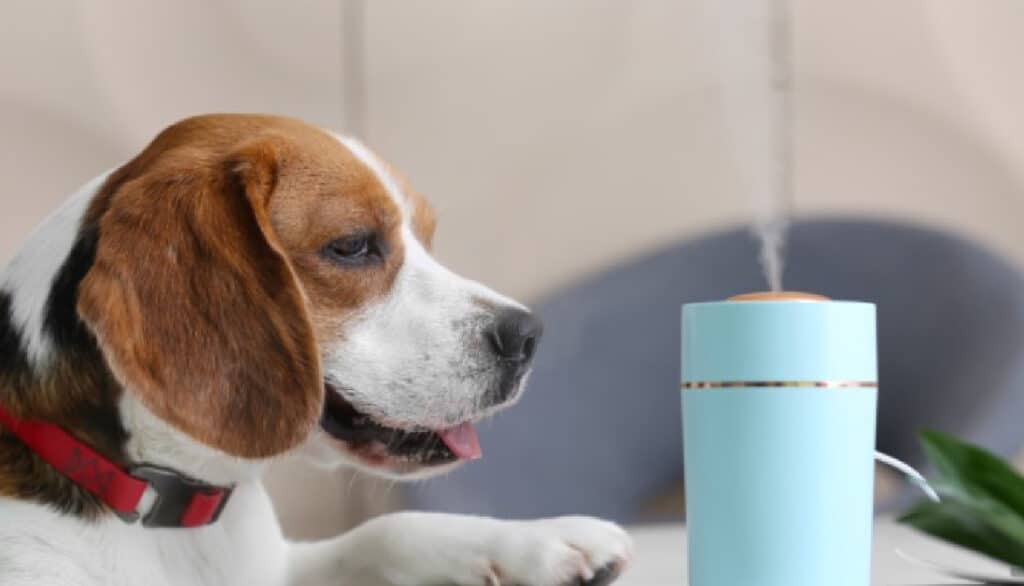
5. Natural Calmatives and Supplements
While setting the mood and mastering the technique are pivotal, sometimes our fur-babies need an extra nudge towards relaxation. Nature offers a variety of gentle helpers that can promote calmness in our pets. So, let’s explore the world of natural calmatives and supplements that can make nail trimming a zen-like experience for your dog.
Herbal Remedies Known to Calm Dogs
- Valerian Root: Often used as a sleep aid for humans, this herb can also help reduce anxiety in dogs. It’s nature’s answer to creating a relaxed state of mind.
- Chamomile: We mentioned it as an essential oil, but chamomile in its natural form or as a tea can also be a mild relaxant for dogs when ingested.
- Passionflower: Historically used to treat restlessness and agitation, passionflower can provide a calming effect without causing drowsiness.
Natural Supplements to Consider
- L-Theanine: An amino acid found in green tea, L-Theanine can promote relaxation and reduce irritability without sedation.
- Hemp Oil or CBD for Dogs: Gaining popularity for its wide range of health benefits, CBD (when derived from hemp and containing 0.3% THC or less) can be a great way to alleviate anxiety in dogs. Always opt for high-quality, pet-specific products.
Calming Treats and Chews
- Pre-Made Options: Several companies offer calming chews or treats infused with a mix of the above ingredients, making it easy to administer before nail trims.
- Homemade Treats: If you’re the DIY type, consider making treats infused with dog-safe calming herbs. Not only do you control the ingredients, but the act of giving a homemade treat can also reinforce your bond.
When to Administer
For most calmatives and supplements, timing is crucial. Administering them 30 minutes to an hour before nail trimming allows them to take effect just when you need them most.
A Friendly Reminder: Always consult your veterinarian before introducing any new supplements or herbs into your dog’s routine. Every dog is unique, and what works for one might not be suitable for another. Plus, it’s essential to ensure there are no interactions with any existing medications or health conditions.
Natural calmatives and supplements are a testament to nature’s brilliance. With their aid, nail trimming can evolve from a dreaded task to a peaceful ritual, drawing you and your canine companion even closer. Mother Nature’s got your back, and so do we! 🌿🐶🍀
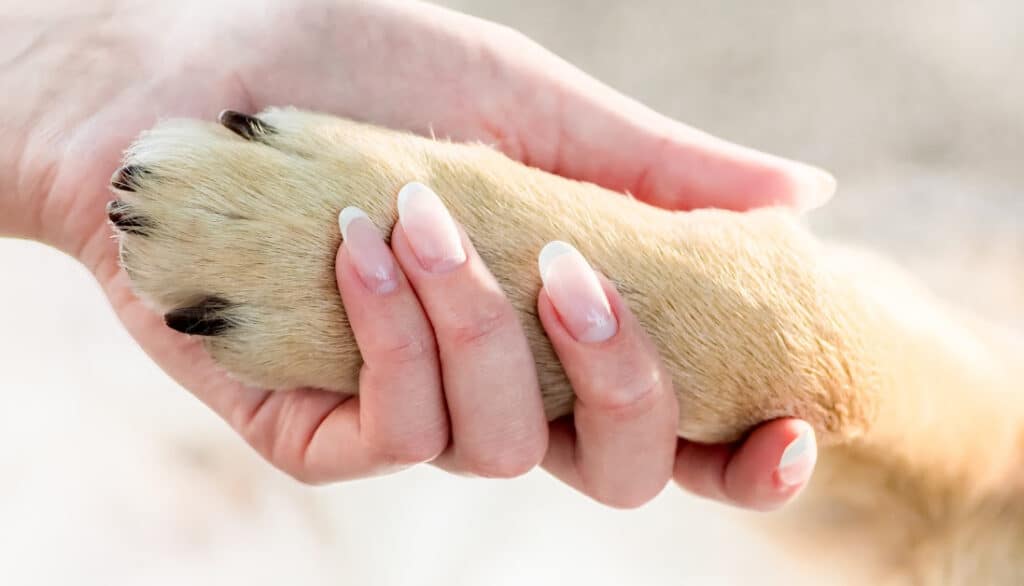
Conclusion
Whew! We’ve traversed quite the journey together, haven’t we? From understanding our dog’s fears to immersing ourselves in the holistic world of natural calmatives. But here’s the crux of it all: nail trimming isn’t merely about grooming—it’s a chance to bond, to communicate, and to showcase our unwavering love and care.
By now, we hope you’re equipped with a toolbox brimming with strategies and tips to make nail trims a more serene experience for both you and your furry friend. Remember, patience is key. Some dogs might take longer to adjust than others, but with consistent effort, understanding, and a lot of heart, even the most nail-trim-averse pup can come around.
Your dog is more than just a pet; they’re family. Every moment, be it playtime or a simple grooming session, is an opportunity to deepen that connection. So the next time you approach those clippers, do it with confidence, armed with knowledge and the comforting thought that you’re doing the best for your canine companion.
Here’s to more wagging tails, contented woofs, and hassle-free nail trims. Until next time, keep pampering those paws and cherish every moment with your four-legged friend! 🐾❤️🌟
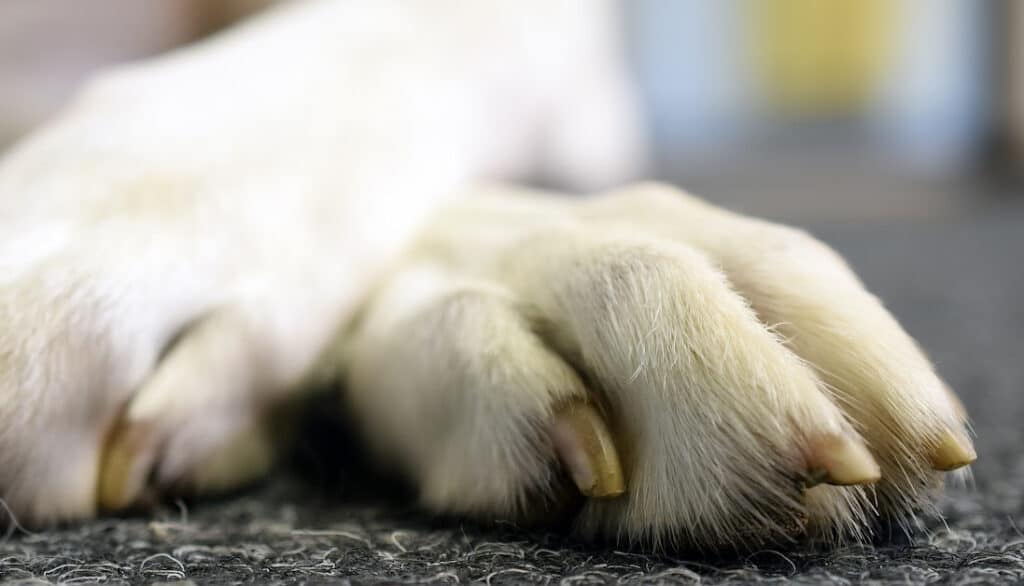
Frequently Asked Questions (FAQs)
Answer: The frequency of nail trims varies depending on your dog’s activity level and where they spend most of their time. Dogs that walk on hard surfaces may naturally wear down their nails and need less frequent trims. However, on average, most dogs will benefit from a nail trim every 3-4 weeks. Always check your dog’s nails regularly and trim when necessary to prevent overgrowth.
Answer: It happens to the best of us! If you accidentally cut the quick, causing it to bleed, remain calm. Apply styptic powder or cornstarch to the bleeding nail to help clot it. Gently press it against the nail for a few seconds. If bleeding continues or if your dog appears in pain, consult your veterinarian.
Answer: Yes, while some essential oils can be beneficial, others can be toxic to dogs. Some oils to avoid include tea tree, cinnamon, citrus, pennyroyal, and many more. Always research and consult with your vet before introducing any new oil to your dog’s environment.
Answer: It’s recommended to use dog-specific nail clippers. Human nail clippers might not be strong enough to cut through a dog’s nail, especially for larger breeds, and could cause splitting or uneven cuts. There are various types of dog nail clippers available, including scissor-type and guillotine-type, to suit different needs.
Answer: If your dog is excessively fearful, it might be beneficial to consult with a professional dog trainer or behaviorist. They can provide specialized techniques tailored to your dog’s needs. In extreme cases, consider seeking the assistance of your vet or a professional groomer who can provide a safe and stress-free experience for your pet.
